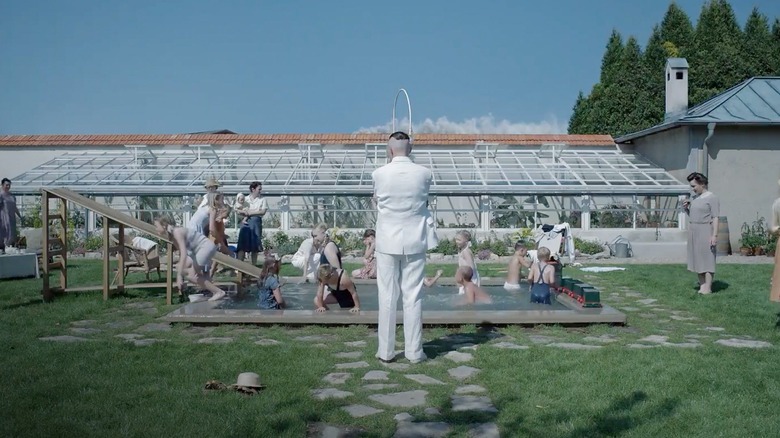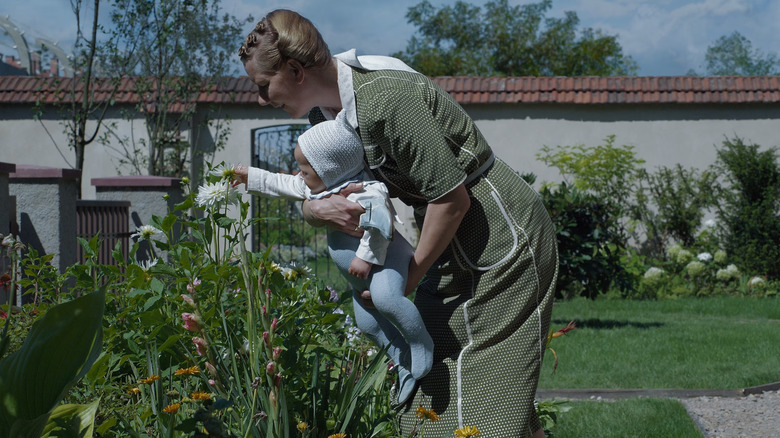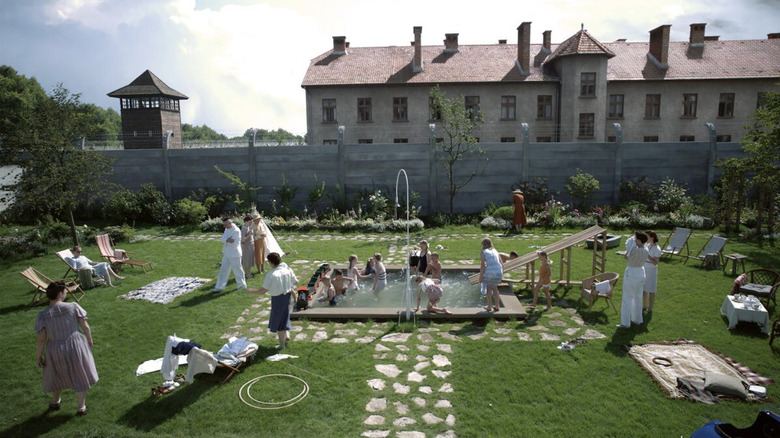How The Zone Of Interest Crafted One Of The Most Disturbing Sound Mixes Ever Heard In A Movie
As a filmmaker and storyteller, Jonathan Glazer has made a career tossing audiences into minefields of morality without a life raft, challenging those at home to sit in ultimate discomfort and better understand characters who, on paper, would typically be avoided. "Sexy Beast" turned Ben Kingsley into one of cinema's greatest villains, "Birth" sees Nicole Kidman questioning all of her morals after a 10-year-old boy claims to be the reincarnation of her dead husband, and people are still trying to fully wrap their heads around the alien skinwalker tale of "Under the Skin." But it's his latest film, "The Zone of Interest," that many are finding to be his most difficult to process yet.
Adapted from Martin Amis' novel of the same name, "The Zone of Interest" (read our 10/10 review here) centers on Auschwitz Commandant Rudolf Höss, who lives an idyllic life with his wife Hedwig and their five children in a beautiful home with servants doing all they can to make their lives as easy and enjoyable as possible. The home is located right next to the concentration camp, meaning that their beautiful life is constantly underscored by the sounds of gunshots, the humming of the incinerator furnace, the chugging of trains bringing in new victims, shouting, screaming, and perhaps worst of all — nothingness.
It's a harrowing answer to a question often posited: "How did we let this happen?" The answer is simple: apathy, bigotry, and compliance. Despite the knowing horrors taking place just beyond the property line, Glazer never shows the inside of the camp. But he doesn't need to, because the sound design of the film guarantees that those watching the film will never forget the atrocities occurring congruent to the events at the house.
The sound mix is its own movie
During a Q&A with Jonathan Glazer livestreamed before screenings presented by the Alamo Drafthouse theaters, the filmmaker explained, "The idea of the film was always that there'd sort of be two films: the film you'd see, and the film you'd hear." In order to present the film as authentically and ethically as possible, Glazer said many of the sounds included to express what was happening from over the wall in the camp were gathered from witness testimonies. "There were no photographs taken inside the camp at that stage, and a lot of our thoughts came from drawings, actually, that were done by prisoners during their imprisonment who drew witness evidence, visual evidence, of the atrocities that were happening among them and around them," he said. "So those provided a lot of information, sonically."
The team also looked toward artists who had survived World War II and channelled their trauma of witnessing the Holocaust into their work, like composer David Olère. From there, sound designer Johnnie Burn captured a series of field recordings to develop the soundscape from actual recordings. "They'd go to Germany — for instance, Berlin at night — and they'd wait for an argument to happen and put themselves somewhere where they could record it," Glazer said of the sound team. In an interview with IndieWire, Burn said that he recorded moments during the Parisian riots for group shouting as well. This prevents the audio from sounding too staged or performative, instead capturing lived-in reality of the sounds that occur when no one knows — or cares — that they can be heard. These elements were then combined with the work of composer Mica Levi, and Glazer and editor Paul Watts made sure the pacing of the film worked well with the sound.
When genocide becomes white noise
If you're neurotypical and have ever lived in an urban area littered with constant noise pollution, you're aware of the adaptation the brain makes to zone out the sound of planes, trains, automobiles, and bustling groups of people. It's a bit of selective protection. If you're neurodivergent, however, you've likely experienced the overwhelming overstimulation of being constantly bombarded by what feels like a wall of sound. "The Zone of Interest" is incredibly distressing not just because we are hyperaware of the genocide taking place just over the family's garden wall, but because for these characters, the sound become nothing more than white noise. Rudolf Höss' family has been fusilladed by the sounds of death for so long that they've figured out a way to "tune out," even complaining when the sounds become intrusive enough to break through the mental blockade and expressing annoyance the way the rest of us would about a particularly chatty bird.
"The Zone of Interest" is an impossibly difficult watch, but what makes it an even tougher pill to swallow is to recognize the similarities between this family learning to ignore the sounds of Auschwitz, and watching so many people in this moment learn to scroll past the countless videos of the multiple genocides occurring around the world (Palestine, Sudan, Congo, Ethiopia, etc.) and the rising targeted hatred towards marginalized identity groups just to get to the latest hot take on Film Twitter. The cognitive dissonance taking place of people musing about the human passivity in the face of abominable actions in "The Zone of Interest" while actively ignoring real-life barbarity happening every single day is enough to make your head spin.
Fight the urge to tune out. Look. Listen. And don't allow yourself to become like the Höss family.


